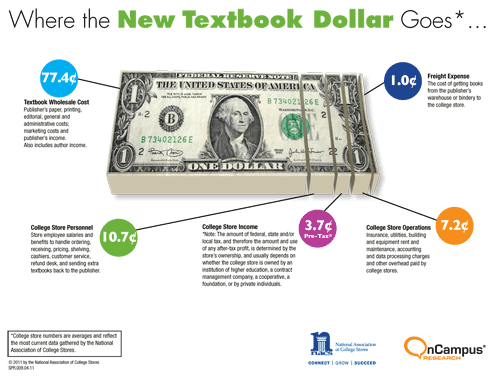Occasionally an initial concern for institutions considering a major OER initiative is, “What will happen to the revenue the college has traditionally received from the bookstore?”
In 2011, NACS (the National Association of College Stores) released this infographic showing where the money students spend on textbooks goes (click the image to link to the original):
According to NACS, the average college bookstore’s pre-tax income on textbooks is 3.7% of the price of the book. In other words, when a student spends $150 on a biology textbook, the college “makes” $5.55.
According to NACS, the publisher gets 77.4% of the price paid by the student. Another 10.7% of the price of the book is tied up in bookstore personnel costs supporting (their examples): ordering, receiving, shelving, refunding, sending extras back to the publisher, cashiers, and customer service. 1% of the cost of the price of the textbook is consumed by physically shipping the book from the publisher to the store. The final 7.2% of the cost of the textbook goes to bookstore overhead.
Now, OER are born digital, and are completely free for students to access and use. There’s no publisher’s percentage, no ordering, no shipping, no receiving, no shelving, no cashiers, no refunds, no sending extra books back to a publisher, etc. But there’s also no revenue returned to the college by the bookstore. So while OER are great for students, they’re the natural born enemy of the bookstore, right?
Actually, I think there’s an opportunity for very productive collaboration between campus-wide OER intiatives and bookstores. Specifically, I think there’s a huge opportunity for bookstores to offer optional print-on-demand to students when faculty adopt OER in place of commercial textbooks.
For example, a single copy of a 500 page open biology textbook ordered print-on-demand from CreateSpace costs $6.85. Let’s round up and say it costs the book store $10 to provide a printed copy of this same title through local means.
Let’s assume that the personnel costs associated with providing print-on-demand are the same as the personnel costs of ordering, shipping, receiving, shelving, refunding, and sending books back (they’re likely not – they’re likely lower – but let’s pretend they’re the same). Let’s also assume that the overhead rate the store needs to charge per book remains the same. We would then need to add 7.2% + 10.7% to the cost of our open biology textbook, so $10 + $0.72 + $1.07 makes a new grand total of $11.79 for the book. Let’s be generous and round up to $12.
Finally, instead of the 3.7% pre-tax profit, let’s say that the college absolutely has to have the same $5.55 profit on this book that they used to enjoy on the $150 book, so that the college doesn’t “lose money” because of their OER initiative. Actually, let’s be generous and round up again – let’s give the college $6 in profit. $12 + $6 = $18.
Here’s the insane part: the college bookstore actually makes more pre-tax profit on the $18 print-on-demand open textbook than they do on the $150 publisher biology book, while earning the same per-book percentages for overhead and personnel.
Now, I’m sure it’s slightly more complicated than this back of the envelope sketch, but the point is that creative bookstores who want to proactively partner with local OER initiatives can provide a real service to students (i.e., optional, aggressively priced print-on-demand versions of OER) and provide the same amount of (or more) revenue back to their college.

This is a great analysis. I think CreateSpace is essential to unlocking OER potential. For my open book, wholesale CreateSpace is $3.75 plus shipping. At $9.99 I make $4.74 per book but no student ever finds CreateSpace. They all find it on Amazon where it is marked down to $8.99 plus shipping with $1.24 profit for me. I can make that same $1.00 selling the books to the bookstore direct from CreateSpace for $4.75 by giving them a discount coupon – the book store can make $5.25 on every book selling at $9.99 – no shipping for the buyer. They can share the $5.25 with the school. There s a nice gap there. If the bookstore could group books into a shipment they could keep inventory to very few books and get one shipment per day. CreateSpace is the future.
Thanks, David. This is exactly what we’ve been doing at the University of Minnesota. Our bookstore is a valued partners in our open textbook initiative. They welcome the opportunity to work with us when print copies of open textbooks are requested. It works well.